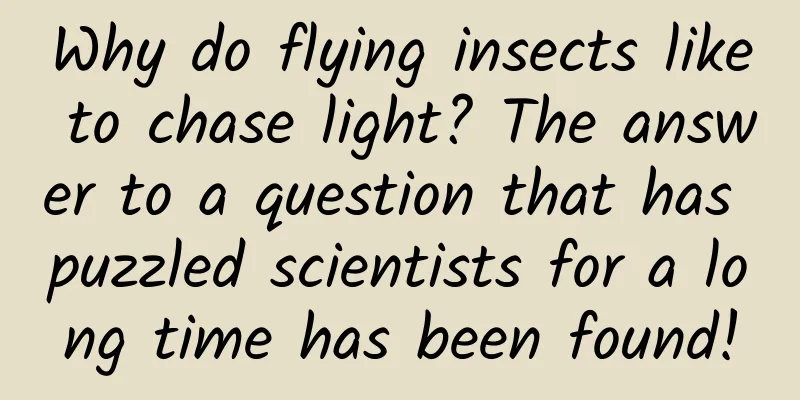Why do flying insects like to chase light? The answer to a question that has puzzled scientists for a long time has been found!

|
Li Zhaoying At night, we often observe an interesting phenomenon, that is, moths and other insects always like to hover around light sources. Sometimes, these insects even die because of this. In fact, as early as around 1 AD in the Roman Empire, there were written records that people would use artificial light to catch insects. But scientists have always been unaware of the real reason why "moths fly into fire". In January of this year, in a new paper published in the journal Nature Communications, researchers used high-resolution motion capture technology to provide a new answer to this ancient mystery. Some past theories <br /> To explain this strange behavior of insects, scientists have proposed many models. For example ●An early theory was that insects were actually attracted to the heat radiation from the light source, not the light itself; However, each of these theories sounds flawed in its own way, so the reason behind this common phenomenon has always been a mystery. Facing the light Finding a definitive answer to this question is difficult because kinematic data to test these theories are scarce. This is partly because 3D tracking of small flying objects in low light is technically challenging, making it nearly impossible for scientists to accurately measure the 3D flight trajectory and direction of flying insects. In the new study, an international research team filmed the high-resolution flight paths and body postures of 10 different insects around artificial lights in the laboratory of Imperial College London and two field experimental sites in Costa Rica. The researchers found that insects are not attracted to distant lights, but are trapped when they are close to artificial light sources. This finding does not match the existing theories. The researchers also observed that insects turn their backs toward the light source. Throughout the long history of insect flight evolution, the brightest part of their field of vision has always been the sky, a powerful guide for them to know which direction is "up." This is true even at night, especially in the shorter wavelength region (less than 450 nanometers). Most flying insects exhibit some form of dorsal-light-response, a behavior that keeps their dorsal side in the brightest visual area. In natural light, this helps them maintain proper flight posture and control. But when they fly toward artificial light, this response causes them to constantly bypass the light source and become trapped near it. The researchers also observed three odd behaviors: orbiting (a steady circular flight path around the light), stalling (a steep climb that gradually slows down until it is motionless) and inversions (the insects flip over and crash).
Once the insects were below the light source, they frequently arched upward, only to invert again once they were above it. The insects kept their dorsal sides facing the light source, even when doing so would have prevented them from continuing their flight or even caused them to crash. When insects fly directly over a light, they often flip over and face their backs to the light again, only to end up falling suddenly. Back in the lab, the researchers attached location markers to five species of insects. They used motion cameras to film their behavior around a UV LED bulb, a UV-blue light tube, and a cool white LED bulb. They found that these artificial light sources significantly changed the insects' ability to control direction, and they all tried to tilt their backs toward the direction of the light. The researchers then used computer modeling to analyze these behaviors and found that this tilt is enough to cause the insects to produce the erratic flight paths that have been observed near light sources. The researchers say this is the most plausible model to explain why flying insects cluster under artificial light. Why are insects, the oldest and most diverse group of flying animals, still relying on a response that puts them in danger ? The researchers think it may have something to do with their small size. Insects have tiny sensory structures. When they fly fast, the accelerations provide a very messy indication of which way is down. So they can only hope for a bright sky. Before modern lighting, the sky was usually brighter than the ground, both during the day and at night, so it provided a fairly reliable reference for insects. The presence of artificial light, however, destroys this ability of insects, causing them to fly around the light source. Light pollution at night Today, with the prevalence of artificial light, many areas no longer have true darkness. This study prompts us to re-examine the light we emit at night. These nighttime light sources have become a form of pollution. And insects are not the only organisms affected. Other animals, plants, and humans have their circadian rhythms and physiological processes disrupted. But insects trapped around artificial light seem to be the most severely affected. They cannot obtain food, are easily discovered by predators, and are easily exhausted. Many insects will die before dawn. In theory, light pollution is an easy problem to fix. We could just flip a switch and limit the brightness and duration of outdoor lighting to only what is necessary, and we could make a big difference in our nighttime ecosystems. Paper link: This article is a work supported by Science Popularization China Starry Sky Project Author Name: Li Zhaoying Review: Zhao Xumao Produced by: China Association for Science and Technology Department of Science Popularization Producer: China Science and Technology Press Co., Ltd., Beijing Zhongke Xinghe Culture Media Co., Ltd. |
<<: "Listening" and "singing" are two different things. Good pitch does not mean good singing!
Recommend
C# 7 Feature Preview
[[165106]] Over the past year, we have shown read...
Setting benchmarks, segmenting, review of Tik Tok content marketing in 2018!
In the blink of an eye, the mobile Internet has b...
Higher Education Policy Institute & Kortext: AI usage among UK university students will reach 92% in 2025, and academic assessment usage will rise to 88%
According to the latest research, the use of gener...
BOE launches 110-inch "4K giant screen" to display 1:1 real-life images
[September 9 news] Yesterday, a message came from ...
Behind Li Jiaqi’s sudden popularity: Is KOC in fashion?
As the Internet traffic dividend disappears, prod...
Fan Life Cycle | Rethinking New Media Operations from the Perspective of Cognitive Bubble
"The world would be better off if most peopl...
78 lines of Python code to help you reproduce WeChat message withdrawal!
Python once said to me: "Time is running out...
Xiao Xiao Sha "Logical Structure Thinking Camp"
Logic is the law and the basis of all thinking. Di...
From ancient times to the present, how have we "dealt with" the wind?
In recent days, strong winds have occurred in man...
How much is the minimum living allowance per month in 2022? Attached are the latest standards from various places!
All Chinese citizens, as long as their family'...
How to use the points system to stimulate user retention (Part 1): Classification and definition of points
The so-called points system is based on points. B...
How much does it cost to go to Thailand: A guide to keyword strategy formulation for online marketing companies!
The online marketing company records the keywords...
Methodology: Brand promotion from 0-1!
Last year, I thought that after working in brand ...
If I give you four chances to travel through time, would you dare to have a blood transfusion?
Should I take this risk or that risk? Compilation...
These 5 changes in iOS14 interaction are worth studying carefully
I have always liked the interactive design of the...


![[Popular Science China Star Chasing Dreams] Long Picture | The "Supercomputing Youth" Behind the "God of Calculation"](/upload/images/67f23e5accb52.webp)






